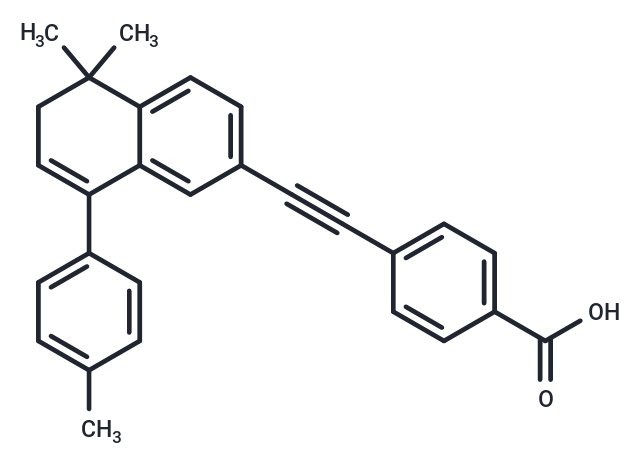Shopping Cart
- Remove All
 Your shopping cart is currently empty
Your shopping cart is currently empty

AGN 193109, a retinoid analog, is a potent and specific antagonist of RARs (Kds: 2 nM, 2 nM, and 3 nM for RARα, RARβ, and RARγ).

| Pack Size | Price | Availability | Quantity |
|---|---|---|---|
| 1 mg | $62 | In Stock | |
| 2 mg | $92 | In Stock | |
| 5 mg | $155 | In Stock | |
| 10 mg | $247 | In Stock | |
| 25 mg | $498 | In Stock | |
| 50 mg | $725 | In Stock | |
| 100 mg | $987 | In Stock |
| Description | AGN 193109, a retinoid analog, is a potent and specific antagonist of RARs (Kds: 2 nM, 2 nM, and 3 nM for RARα, RARβ, and RARγ). |
| Targets&IC50 | RARα:2 nM (Kd), RARγ:3 nM (Kd), RARβ:2 nM (Kd) |
| In vitro | AGN 193109 is completely RAR specific because it does not bind to or transactivate through any of the RXRs [1]. AGN 193109 (100 nM) inhibits the TTNPB (a retinoic acid receptor agonist)-dependent morphological change in ECE16-1 cells. AGN193109 half-reverses retinoid-dependent growth suppression at 10 nM, and completely shows this effect at 100 nM in ECE16-1 cells. AGN193109 (100 nM) also eliminates TTNPB-induced decrease in levels of K5, K6, K14, K16, and K17 and increases in levels of K7, K8, and K19 [2]. |
| In vivo | Topical administration of AGN 193109 at doses of 0.30 or 1.20 μmol/kg significantly mitigates weight loss and cutaneous toxicity associated with concurrent oral TTNPB treatment. A dose of 1.15 μmol/kg AGN 193109 exhibits no apparent toxicity and does not influence spleen weight in mice, yet effectively inhibits the TTNPB-induced spleen weight increase. Furthermore, AGN 193109 notably attenuates ATRA-induced cutaneous toxicity. |
| Cell Research | Cells (10,000/cm2) are seeded in complete medium and allowed to attach overnight. The cells are then shifted to defined medium (DM), allowed to equilibrate for 24 h, and treatment is initiated by the addition of fresh DM or DM containing epidermal growth factor (EGF) or retinoid. After 3 days of daily treatment with retinoid, the cells are harvested with 0.025% trypsin, 1 mM EDTA, fixed in isotonic buffer containing 4% formaldehyde, and counted using a counter [2]. |
| Animal Research | Mice (n=6) are treated topically on the dorsal skin with vehicle (92.5% acetone/7.5% DMSO), 0.072 μmol/kg of TTNPB, 1.15 μmol/kg of AGN 193109, or 0.072 μmol/kg of TTNPB plus 0.072, 0.288, or 1.15 μmol/kg of AGN 193109 for 5 days. Mice are euthanized on Day 8 [3]. |
| Molecular Weight | 392.49 |
| Formula | C28H24O2 |
| Cas No. | 171746-21-7 |
| Smiles | Cc1ccc(cc1)C1=CCC(C)(C)c2ccc(cc12)C#Cc1ccc(cc1)C(O)=O |
| Relative Density. | 1.21 g/cm3 (Predicted) |
| Storage | Powder: -20°C for 3 years | In solvent: -80°C for 1 year | Shipping with blue ice. | |||||||||||||||
| Solubility Information | DMSO: 3.92 mg/mL (9.99 mM), Sonication is recommended. | |||||||||||||||
Solution Preparation Table | ||||||||||||||||
DMSO
| ||||||||||||||||

Copyright © 2015-2025 TargetMol Chemicals Inc. All Rights Reserved.